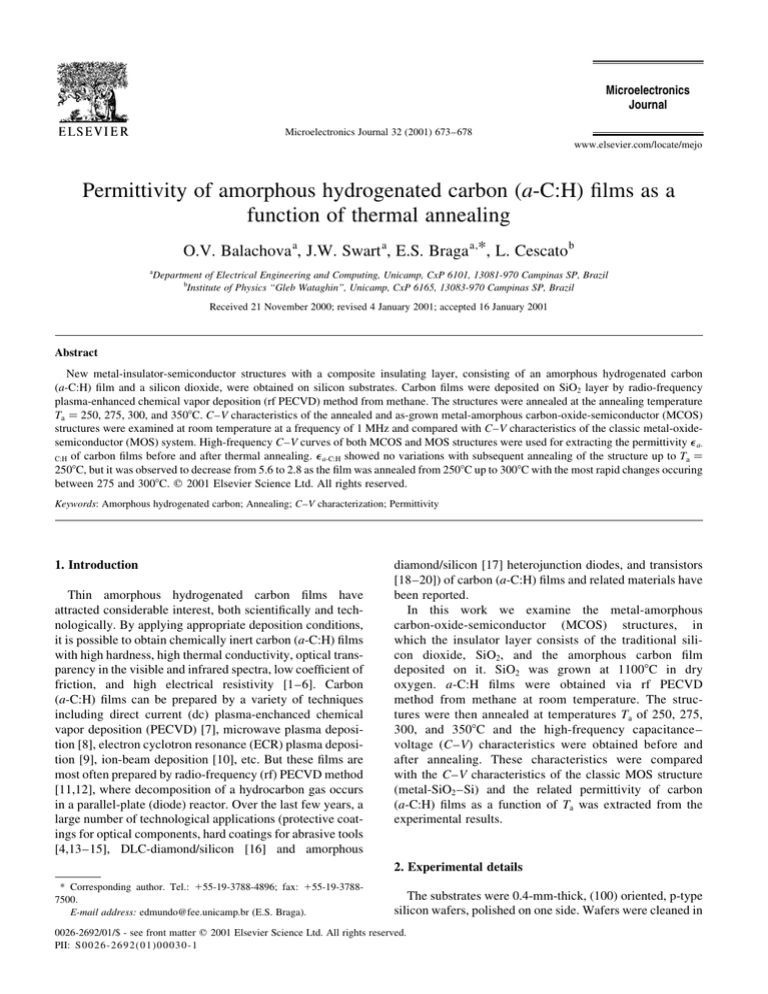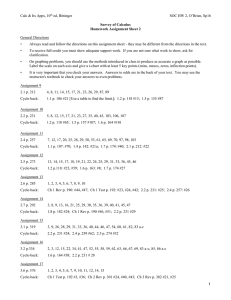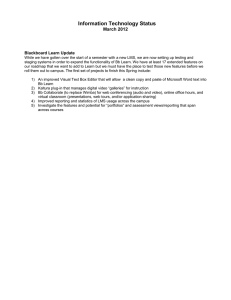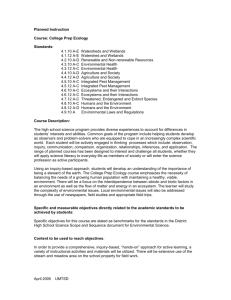
Microelectronics
Journal
Microelectronics Journal 32 (2001) 673±678
www.elsevier.com/locate/mejo
Permittivity of amorphous hydrogenated carbon (a-C:H) ®lms as a
function of thermal annealing
O.V. Balachova a, J.W. Swart a, E.S. Braga a,*, L. Cescato b
a
Department of Electrical Engineering and Computing, Unicamp, CxP 6101, 13081-970 Campinas SP, Brazil
b
Institute of Physics ªGleb Wataghinº, Unicamp, CxP 6165, 13083-970 Campinas SP, Brazil
Received 21 November 2000; revised 4 January 2001; accepted 16 January 2001
Abstract
New metal-insulator-semiconductor structures with a composite insulating layer, consisting of an amorphous hydrogenated carbon
(a-C:H) ®lm and a silicon dioxide, were obtained on silicon substrates. Carbon ®lms were deposited on SiO2 layer by radio-frequency
plasma-enhanced chemical vapor deposition (rf PECVD) method from methane. The structures were annealed at the annealing temperature
Ta 250; 275, 300, and 3508C. C±V characteristics of the annealed and as-grown metal-amorphous carbon-oxide-semiconductor (MCOS)
structures were examined at room temperature at a frequency of 1 MHz and compared with C±V characteristics of the classic metal-oxidesemiconductor (MOS) system. High-frequency C±V curves of both MCOS and MOS structures were used for extracting the permittivity e aC:H of carbon ®lms before and after thermal annealing. e a-C:H showed no variations with subsequent annealing of the structure up to Ta
2508C; but it was observed to decrease from 5.6 to 2.8 as the ®lm was annealed from 2508C up to 3008C with the most rapid changes occuring
between 275 and 3008C. q 2001 Elsevier Science Ltd. All rights reserved.
Keywords: Amorphous hydrogenated carbon; Annealing; C±V characterization; Permittivity
1. Introduction
Thin amorphous hydrogenated carbon ®lms have
attracted considerable interest, both scienti®cally and technologically. By applying appropriate deposition conditions,
it is possible to obtain chemically inert carbon (a-C:H) ®lms
with high hardness, high thermal conductivity, optical transparency in the visible and infrared spectra, low coef®cient of
friction, and high electrical resistivity [1±6]. Carbon
(a-C:H) ®lms can be prepared by a variety of techniques
including direct current (dc) plasma-enchanced chemical
vapor deposition (PECVD) [7], microwave plasma deposition [8], electron cyclotron resonance (ECR) plasma deposition [9], ion-beam deposition [10], etc. But these ®lms are
most often prepared by radio-frequency (rf) PECVD method
[11,12], where decomposition of a hydrocarbon gas occurs
in a parallel-plate (diode) reactor. Over the last few years, a
large number of technological applications (protective coatings for optical components, hard coatings for abrasive tools
[4,13±15], DLC-diamond/silicon [16] and amorphous
diamond/silicon [17] heterojunction diodes, and transistors
[18±20]) of carbon (a-C:H) ®lms and related materials have
been reported.
In this work we examine the metal-amorphous
carbon-oxide-semiconductor (MCOS) structures, in
which the insulator layer consists of the traditional silicon dioxide, SiO2, and the amorphous carbon ®lm
deposited on it. SiO2 was grown at 11008C in dry
oxygen. a-C:H ®lms were obtained via rf PECVD
method from methane at room temperature. The structures were then annealed at temperatures Ta of 250, 275,
300, and 3508C and the high-frequency capacitance±
voltage (C±V) characteristics were obtained before and
after annealing. These characteristics were compared
with the C±V characteristics of the classic MOS structure
(metal-SiO2 ±Si) and the related permittivity of carbon
(a-C:H) ®lms as a function of Ta was extracted from the
experimental results.
2. Experimental details
* Corresponding author. Tel.: 155-19-3788-4896; fax: 155-19-37887500.
E-mail address: edmundo@fee.unicamp.br (E.S. Braga).
The substrates were 0.4-mm-thick, (100) oriented, p-type
silicon wafers, polished on one side. Wafers were cleaned in
0026-2692/01/$ - see front matter q 2001 Elsevier Science Ltd. All rights reserved.
PII: S 0026-269 2(01)00030-1
674
O.V. Balachova et al. / Microelectronics Journal 32 (2001) 673±678
Fig. 1. MCOS (a) and MOS (b) structures.
(H2SO4 1 H2O2)
solution,
(HF 1 H2O)
solution
(NH4OH 1 H2O2 1 H2O) and (HCl 1 H2O2 1 H2O) solutions, washed in running DI water and dried with a
nitrogen jet. They were thermally oxidized at 11008C in
dry oxygen.
Amorphous hydrogenated carbon (a-C:H) ®lms were
then deposited on a polished (top) side of the substrates
by PECVD technique in a rf apparatus, using CH4 as a
reactant gas. The glow discharge was sustained by an rf
power generator, supplied to the lower electrode
through an impedance matching network. Both the
upper electrode and the chamber wall were grounded.
The substrates were placed on the water cooled lower
electrode. The (a-C:H) ®lms were prepared at a frequency of
13.56 MHz and a pressure of 1 £ 10 21 mbar. The deposition
time was 4 min., and the carbon ®lm thickness was about
Ê . The resistivity of the ®lms were found to be 10 7 ±
1090 A
8
10 V cm.
To provide the ohmic contact to the (a-C:H), Al about
Ê thick was deposited onto the carbon layer in a high
4500 A
vacuum system by evaporation.
After metalization, the top side of the wafers was
spin-coated with photoresist and a mask (500 £ 500 mm 2
quadrates) was patterned on it using conventional
Ê.
Fig. 2. C±V curves of the as-grown MCOS and MOS structures. Oxide thickness is 670 A
O.V. Balachova et al. / Microelectronics Journal 32 (2001) 673±678
photolithography. Metal and the (a-C:H) ®lm from the
open areas were then etched away in (H3PO4 1 HNO3)
solution and oxygen plasma, consequently. Resist was
rinsed away with acetone. SiO2 from the bottom side
of the wafers was removed in (HF 1 H2O) solution.
The wafers were rinsed in DI water for 10 min and
dried with nitrogen jet. In order to provide a good
ohmic contact on the back side of the substrates, the
clean Si surface was covered with a highly conductive silver
paint.
At the same time, the traditional metal-oxide-semiconductor (MOS) structures were obtained on silicon
wafers. The process of oxidation of the Si substrates
for the MCOS and MOS structures was carried out at
the same conditions in order to obtain the identical SiO2
layers for both structures. The ®nal products are shown
in Fig. 1.
Both MCOS and MOS structures were annealed at
temperatures of 250, 275, 300, and 3508C for 45 min. Capacitance measurements were performed at room temperature
in the dark for all structures before and after annealing.
Capacitance was measured as a function of gate bias at a
®xed frequency (1 MHz) by the well-known capacitance
method described in [21].
Thickness of the as-grown and annealed ®lms was
measured with a DEKTAK 3 pro®lometer.
675
3. Results and discussion
For the carbon-SiO2 insulating layer, the total insulator
capacitance Cins. is a series combination of the carbon ®lm
capacitance Ca-C:H and the oxide capacitance Cox.:
C ins:
Ca-C:H £ Cox:
Ca-C:H 1 Cox:
1
Cox: £ Cins:
Cox: 2 Cins:
2
thus,
Ca-C:H
The corresponding permittivity of the (a-C:H) ®lm is given
by
ea-C:H
Ca-C:H £ da-C:H
A £ e0
3
where da-C:H is the thickness of the carbon ®lm, A is the
electrode area, and e 0 is the permittivity in vacuum.
The typical C±V characteristics of the as-grown
MCOS and MOS systems are shown in Fig. 2. As is
well-known [22], the value of the insulator capacitance
Ê.
Fig. 3. C±V curves of the as-grown and annealed (2508C £ 45 min). MCOS structures, oxide thickness is 950 A
676
O.V. Balachova et al. / Microelectronics Journal 32 (2001) 673±678
of any metal-insulator-semiconductor system corresponds to the maximum capacitance (accumulation
region) of the system for a given insulator thickness.
Thus, the values Cins. and Cox. (Eq. (2)) can be extracted
from the MCOS and MOS curves (Fig. 2), respectively.
Note that Cox. for the MCOS system was obtained from
the MOS C±V curve because the oxide layers for both
structures were grown at the same conditions and were
found to be identical. Thus, for a set of given Cins., Cox.,
da-C:H, A, and e 0, one can determine the carbon ®lm
permittivity from Eqs. (2) and (3). This value was estimated to be 5.5 for the as-grown (a-C:H) ®lms. This is
higher than that (2.2) obtained in Ref. [23], where the
metal-amorphous carbon±silicon (MCS) structures were
used.
The reason for this difference is not totally clear. It
can possibly be explained by employing different
deposition conditions, which could lead to considerable
deviation in carbon ®lm composition, especially in
hydrogen content; and, partly, by using the different
metal-insulator-silicon structure in the capacitance
measurements than Chan et al. [24] did. As it has
been reported in literature [17,23,24], although the resistivity of amorphous carbon ®lms is about 10 7 ±
10 8 V cm, they have semiconductive properties. When
the MCS structure is measured [24], the effects at the
(a-C:H)/Si interface, which we will not discuss here,
can have an in¯uence on the ®nal result, but this contribution is dif®cult to calculate. In case of the MCOS
structures, the carbon layer is isolated from the silicon
by the oxide layer with a resistivity of 10 14 ±10 16 V cm
[22]. Electrically, the (a-C:H)/SiO2 contact seems to be
`more ideal' than the (a-C:H)/Si interface due to the
high resistivity of both carbon ®lm and SiO2. In this
case, the MCOS system under study is a combination
of the MOS system and the carbon insulating layer, where
the MOS parameters can be easily determined by measuring
the classic structure.
The C±V measurements of the annealed MOS structures
showed no changes in the oxide capacitance.
The C±V curves of the annealed MCOS structures are
shown in Figs. 3±5. For the low Ta (2508C), no changes in
Cins. were observed and, therefore, no changes in Ca-C:H and
e a-C:H were registered.
Ê.
Fig. 4. C±V curves of the as-grown and annealed (2758C £ 45 min). MCOS structures, oxide thickness is 1620 A
O.V. Balachova et al. / Microelectronics Journal 32 (2001) 673±678
677
Ê.
Fig. 5. C±V curves of the as-grown and annealed (3008C £ 45 min). MCOS structures, oxide thickness is 1160 A
As the temperature increases up to 2758C, a little insulator capacitance fall was observed (Fig. 4) indicating a
Ca-C:H and e a-C:H decrease. The value of e a-C:H was estimated
to be 4.7 for the ®lms annealed at 2758C.
The signi®cant decrease in Cins. was registered at the
3008C anneal (Fig. 5). For this temperature, e a-C:H was
found to be 2.8.
Results for e a-C:H for the carbon ®lms as-grown and
following the 250, 275, and 3008C anneals are shown in
Fig. 6. Note that the most rapid decrease in the ®lm permittivity occurs between 275 and 3008C.
At the same time, no changes in ®lm thickness
were registered for the ®lms annealed in the range
250±3008C. It means that the decrease in permittivity
of the studied ®lms occurs due to the structural rearrangements, probably caused by the conversion of
weakly bonded hydrogen into normally bonded
hydrogen [25].
The decrease in ®lm thickness begins in the range
300±3508C. As it was observed, at 3508C carbon
(a-C:H) ®lms lose almost 50% of their thickness and
also their transparency and adhesion to the substrate.
Such big mass loss indicates that probably, not only
hydrogen, but also carbon begins being volatilized. It
was not possible to measure the C±V characteristics
of the MCOS system after 3508C anneal because of
the bad capacitor conditions.
4. Conclusions
We have presented experimental results for the
permittivity e a-C:H of carbon ®lms both in the as-grown
state and also in the annealed state (T a 250; 275,
3008C). The relative ®lm permittivity appears to be
constant (5.5) up to Ta 2508C: For higher anneals
e a-C:H decreases from 5.5 to 2.8
Ta 3008C: It is
suggested that the decrease in permittivity in the
range 250±3008C is associated with the structural rearrangements in the (a-C:H) ®lm, and not the material
evolution. Further annealing (3508C) leads to the ®lm
degradation.
678
O.V. Balachova et al. / Microelectronics Journal 32 (2001) 673±678
Fig. 6. Permittivity of carbon (a-C:H) ®lms as a function of Ta.
Acknowledgements
The authors would like to express the gratitude to
FAPESP (FundacËaÄo de Amparo aÁ Pesquisa do Estado de
SaÄo Paulo), FINEP/PADCT (Financiadora de Estudos e
Projetos) and CNPq (Conselho Nacional de Pesquisas) for
the ®nancial support of this project.
References
[1] F.C. Marques, R.G. Lacerda, G.Y. Odo, C.M. Lepienski, Thin Solid
Films 332 (1998) 113.
[2] R.G. Lacerda, F.C. Marques, Appl. Phys. Lett. 73 (1998) 617.
[3] C. Gu, Z. Jin, X. Lu, G. Zou, J. Zhang, R. Fang, Thin Solid Films 311
(1997) 124.
[4] A. Bubenzer, B. Dischler, G. Brandt, P. Koidl, J. Appl. Phys. 54
(1983) 4590.
[5] B. Dischler, A. Bubenzer, P. Koidl, Appl. Phys. Lett. 42 (1983) 636.
[6] A. Bubenzer, B. Dischler, A. Nyaiesh, Thin Solid Films 91 (1982) 81.
[7] N. Fourches, G. Turban, Thin Solid Films 240 (1994) 28.
[8] M. Kamo, Y. Sato, S. Matsumoto, N. Setaka, J. Cryst. Growth 62
(1983) 642.
[9] W. Scharff, K. Hammer, O. Stenzel, J. Ullmann, M. Vogel,
T. Frauenheim, B. Eibish, S. Roth, S. Schulze, I. Muehling, Thin
Solid Films 171 (1989) 157.
[10] S. Aisenberg, R. Chabot, J. Appl. Phys. 42 (1971) 2953.
[11] Z. Has', S. Mitura, M. Clapa, J. Szmidt, Thin Solid Films 136 (1985)
161.
[12] L. Holland, S.M. Ojha, Thin Solid Films 58 (1979) 107.
[13] J.C. Angus, C.C. Hayman, Science 241 (1988) 913.
[14] K.V. Ravi, Mater. Sci. Engng. B 19 (1993) 203.
[15] C.V. Deshpandey, R.F. Bunshan, J. Vac. Sci. Technol. A 7 (1989)
2294.
[16] G. Amaratunga, W. Milne, A. Putnis, IEEE Electron Device Lett. 11
(1990) 33.
[17] G. Amaratunga, D. Segal, D. McKenzie, Appl. Phys. Lett. 59 (1991)
69.
[18] M. Geiss, D. Rathman, D. Ehrlich, R. Murphy, W. Lindley, IEEE
Electron Device Lett. 8 (1987) 341.
[19] J. Prins, Appl. Phys. Lett. 41 (1982) 950.
[20] W. Tsai, M. Del®na, D. Hodul, M. Riaziat, L.Y. Ching, G. Reynolds,
C.B. Cooper III, IEEE Electron Device Lett. 12 (1991) 157.
[21] E.H. Nicollian, J.R. Brews, MOS (Metal Oxide Semiconductor)
Physics and Technology, Wiley, New York, 1982.
[22] S.M. Sze, Physics of Semiconductor Devices, Wiley, New York,
1981.
[23] K.K. Chan, S.R.P. Silva, G.A.J. Amaratunga, Thin Solid Films 212
(1992) 232.
[24] K.K. Chan, G.A.J. Amaratunga, S.P. Wong, V.S. Veersamy, SolidState Electron. 36 (1993) 345.
[25] B. Dischler, A. Bubenzer, P. Koidl, Solid-State Commun. 48 (1983)
105.






